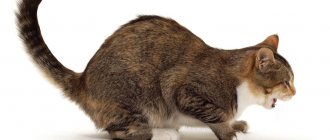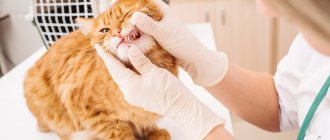With the help of hearing, animals navigate in space and sense the distance to the source of noise or a hypothetical thunderstorm. Hearing loss in a domestic cat is unpleasant, but not fatal. A deaf cat is quite capable of living a full life, after some adaptation. If we consider the issue globally, hearing loss can be explained by several factors - genetic disorders, diseases or injuries, abnormalities in the functioning of the central nervous system.
Classification of deafness
Depending on the origin, deafness in cats can be congenital or acquired.
Congenital deafness can have two causes:
- pathologies of intrauterine development of the fetus, leading to disruption of conductivity or perception of sounds in the structures of the hearing organ;
- aggravated heredity - the presence of the white coat color gene W.
Acquired hearing loss that develops into deafness can be acute or chronic.
- acute deafness occurs suddenly, symptoms increase rapidly over a short period of time;
- Chronic deafness develops gradually over many months or even years. A distinction is made between stable and progressive deafness.
How to help an animal learn to live in silence
If you suspect deafness in a cat, it is better not to guess, but to show it to a veterinarian
For a comfortable existence, the animal must be provided with the safest possible living conditions:
- isolate from the street;
- add tactile contact when you say hello, goodbye, or reward your pet;
- use a special collar with a bell so as not to lose your pet;
- To prevent the animal from being frightened, create additional vibration when it appears.
Your pet can adjust to hearing loss and learn to understand gesture commands and even read lips. To do this, the animal needs patience, attention and support from the owner.
The cat is beautiful." Some people like fluffy, healthy cats, while others are crazy about statue-like graceful cats whose skin is not covered with hair. But almost everyone agrees that snow-white cats with blue eyes are among the most beautiful.
Unfortunately, there is a myth that white cats cannot hear anything. People believe that if a cat has beautiful white fur and light, bottomless eyes, then with almost one hundred percent probability this cat is deaf. Is it really?
Types of deafness by level of damage
- Conductive hearing loss is acquired. A pathological obstruction occurs in the path of sound transmission or amplification in the ear. This disorder can occur at the level of the outer ear (this includes malformations, cerumen plugs, otitis or neoplasms, ear parasites) or the middle ear (injuries and malformations of the eardrum, otitis media, otosclerosis). If the disease that caused the pathology is curable, then this type of deafness is reversible.
- Sensorineural deafness is often congenital. Most often, this is a pathology of the inner ear, which is a damage to the sensors - the hair cells of the inner ear. With their help, mechanical vibrations are converted into electrical impulses. This also includes pathologies of the auditory nerve. The perception of sound with this type of deafness is distorted or disappears completely. When the disease is acquired, its cause is often infectious diseases (meningitis, encephalitis), autoimmune diseases (Wegener's granulomatosis), as well as microcirculatory disorders in the inner ear, Mernier's disease.
- Central deafness occurs due to severe pathologies of the central nervous system and brain in cats. Its percentage in the total number of cases of deafness is small.
- Age-related deafness is a consequence of degenerative processes in the body of an animal on the verge of old age. The disease begins with the appearance of senile hearing loss in older individuals. It is slowly progressive and irreversible, and finally gives way to complete deafness.
Main causes of feline deafness
As we have already written, the reasons for the disappearance or significant weakening of hearing are very diverse, but we will describe the most important ones.
Deafness after otitis media: why is this phenomenon dangerous?
Perhaps the complete or partial disappearance of hearing after, i.e. inflammatory process in the inner ear is one of the most common phenomena in veterinary otolaryngology. This is due to the fact that not all owners understand the potential danger of this pathology.
Important! If purulent inflammation develops in the cavity of the inner ear, accompanied by the release of pus, nothing good will come of it.
Pus is a powerful natural “solvent” that can damage and liquefy not only soft tissue, but even bones. Accordingly, after prolonged otitis media, the likelihood of hearing deterioration is extremely high.
Accordingly, it is not difficult to guess about the potential danger of this phenomenon: the hearing organs are located in close proximity to the brain. In addition, there are many blood vessels there.
If otitis media is not treated at all, deafness can become the cat’s smallest problem. He may well die from brain damage, sepsis or similar causes.
Senile hearing loss in cats
With age, pets (and pet owners) do not become healthier. In particular, the blood supply to the tissues in the hearing organs deteriorates, the eardrum becomes “flabby,” and other negative changes accumulate. Senile hearing loss occurs. Alas, nothing can be done about it; old age will take its toll in any case.
Considering that cats are animals with a fairly decent lifespan (subject to normal maintenance and feeding), their hearing begins to deteriorate no earlier than ten years of age. It happens that pets who live to be 14 or more years old hear almost nothing. True, this is not their most serious problem: by this time cats often go blind.
Congenital deafness in cats, its breed variations
The most problematic may be congenital deafness. The following negative environmental factors (as well as their combination) often lead to its development:
But still, the real “leaders” in the issue of congenital hearing loss are some breeds, some of which we will talk about below.
Features of congenital deafness
Many owners know the fact that white cats with blue eyes often have a congenital defect such as deafness. Such cats have a special dominant W gene in their genotype. It is the presence of this gene that makes the likelihood that a white cat will be deaf very high. In some cases it reaches 80%. In turn, congenital deafness in individuals of a different color is an extremely rare phenomenon.
The dominant W gene is pleiotropic, that is, it is responsible for the presence of several traits at once. In addition to white coat color and deafness, it also makes blue eye color dominant. The probability of deafness among white individuals is distributed as follows:
- animals with blue eyes are deaf in 80% of cases;
- animals with heterochromic eyes (one eye is blue and the other is a different color) are deaf in 40% of cases;
- animals with eyes of any color (except blue) are deaf in 20% of cases.
It has been noted that deafness in white cats, caused by the presence of this gene, can be either unilateral or bilateral (long-haired beauties most often suffer from it).
How does deafness develop in white individuals?
It is known that absolutely all kittens are born deaf, with closed ear canals. By the age of 5-7 days they gradually open. At the age of two weeks, the kitten is able to determine the direction of a sound, and by a month, it can already distinguish sounds. In a white kitten, due to genetic disorders, by the time the ears open (at a week of age), the organ of Corti, the receptor part of the auditory analyzer, located in the auditory labyrinth and responsible for analyzing sound signals, atrophies.
Features of natural and artificial selection of white cats
In the wild, white cats survive much less often than others, since they turn out to be much less adapted to the unfavorable factors of the surrounding reality. The reasons for this are as follows:
- high probability of deafness;
- photophobia, which is promoted by a light shade of the eyes;
- poor vision in low light conditions.
In conditions of artificial breeding, white cats are very popular because they have an attractive appearance. They are actively bred, despite the high likelihood of physical defects.
Signs of deafness in a cat
Congenital deafness in cats is most often hereditary.
The cat's gradually developing hearing loss is compensated for by an exacerbation of her sense of smell and touch, which complicates the diagnostic process. Symptoms of complete hearing loss in an animal:
- the pet makes unnaturally loud sounds when meowing;
- does not respond to voices;
- behaves fearfully and insecurely, constantly looking around;
- May scratch ears, shake head, and show other signs of discomfort;
- peeling of the skin around the ears is observed;
- When infected, exudate is released from the ears, which has an extremely foul odor.
To test an animal’s hearing, you need to position yourself in its visibility zone and strike on any hard surface. It is necessary to alternate sounds correctly - from a dull blow to a sharp one, and from a quiet one to a loud one. A healthy pet should respond to a barely audible echo by turning its ears, and to a loud one by turning its head or torso.
Causes of acquired deafness
The most common causes of acquired deafness are:
- Traumatic damage to the integrity of the eardrum. These are caused by falls from heights, blows, inept ear cleaning or acoustic trauma.
- Complications of infectious diseases. With advanced otitis media, the internal structures of the ear are involved in the inflammatory process, and the pet may become deaf. If the disease progresses and is complicated by purulent inflammation affecting the meninges, there will be a real threat to the animal’s life.
- Tumors of the ear structures or parts of the brain responsible for hearing function are the most difficult in terms of treatment and prognosis. Irreversible changes may occur.
- Ear parasites cause temporary hearing loss. Severe itching leads to severe scratching and injury to the outer ear structures. Competent and timely treatment can completely correct the situation.
- Ear plugs are a consequence of poor hygiene. Your cat's ears should be cleaned regularly to remove any wax that has accumulated there. Increased sulfur production is usually evidence of a malfunction of the excretory system.
- Age-related deafness in older cats is an inevitable symptom that is a sign of degenerative changes in the auditory nerve or structures of the inner ear.
Why do many people think that white cats are deaf?
The fact is that in snow-whites the epistatic gene W is dominant. It is often confused with albinism, but in fact it is not the same thing at all.
It is the presence of this gene that explains the fact that 2 out of 10 white cats actually cannot hear anything. But this gene can, with a high degree of probability, appear in the genotype of red, black, and even tabby cats, and they can also turn out to be deaf. Moreover, this gene is passed from parent to offspring, so some of the kittens in such a litter may be deaf, regardless of their fur color. But albinism, which is in no way connected with deafness, is responsible for the white color of the coat.
Symptoms of the disease
Cats adapt well to their condition at the expense of their other senses. There is a certain belief that their sensitivity is so heightened that they hear by perceiving sound vibrations in the bones of the skeleton and vibrissae. They sense movement behind them by vibrations in the air.
And yet, the onset of deafness can be determined. It is usually accompanied by the following symptoms:
- meowing too loudly;
- lack of reaction to opening the refrigerator door or to the rustling of a bag of food;
- loss of orientation, frequent looking around;
- shaking the head, rubbing the ears with a paw;
- in case of an infectious disease or sulfur plugs, an unpleasant odor may be felt;
- The old cat doesn't respond to his name.
To confirm your suspicions, you need to make some sound at some distance from the animal. A well-hearing cat will react by turning its ears. A louder sound will cause fear and a reaction from the whole body. If these signs are not present, it means that the fears have been confirmed, and the cat cannot hear at all.
Symptoms
- Pet does not respond to commands
- Reacts only when you are in the cat's field of view
- Sleeps more than usual
- Wakes up only from touch
- Your pet doesn’t know which way to run when you call him.
- Shakes head or touches ears
When your cat becomes deaf and you, not knowing what to do, are looking for advice on this topic on the Internet on forums, we recommend not to self-medicate or experiment on your beloved cat. The fact is that there are many causes of hearing loss in an animal, and the consequences of your experiment may disappoint you and your family.
Diagnosis of the disease
If symptoms of deafness appear, you should show your pet to a veterinarian; only he will be able to professionally determine the presence of deafness, its level, and the cause. The following methods exist for this:
- Examination of the auricle and inner ear (using a special device - an otoscope). This allows you to determine the presence of injuries, infections, and ear parasites.
- If an infection is detected, an additional cytological examination is performed.
- The presence of genetically determined deafness can be verified using a special instrumental study that allows one to determine the auditory potential of the brain stem when the hearing organ is irritated by sound vibrations.
- If the presence of neoplasms is suspected, magnetic resonance or computed tomography is used.
Treatment
Treatment for your pet will be prescribed based on tests, medical and neurological examination, and physical examination.
Deafness can be corrected if the cause is, for example, wax accumulation or infection. Cleaning the ear opening should be done with care to avoid damaging the eardrum. This procedure should be carried out by a veterinarian using a cotton applicator. Cleaning of heavily soiled ears can be done under general anesthesia.
If an infection is detected, antibiotics will help.
For bilateral deafness, medications, surgery, or a hearing aid may be used. But it is worth paying attention to the fact that the hearing aid may interfere with your pet and he will try to get rid of it.
Treatment of the disease
Treatment methods for deafness vary depending on the causes that cause it:
- Congenital deafness in white cats cannot be treated. From birth, such a cat needs special conditions of care and special methods of communication with the owner.
- Treatment of ear infections or ear parasites is carried out using antimicrobial and antiparasitic agents, respectively, in combination with pain medications.
- Benign and malignant neoplasms can only be cured surgically, after which the animal is subjected to chemotherapy to eliminate the consequences of the disease.
- Ear plugs are removed mechanically, very carefully penetrating the ear cavity with a swab and a cotton swab.
Treatment of deafness in cats
Alas, full treatment is impossible in most cases. Of course, you can sew up the eardrum, you can remove excess wax and other dirt that clogs the ear canal, but nothing can be done about congenital hearing loss. The same applies to the consequences of advanced hearing diseases. Functional tissue damage in such cases is so great that there is no talk of even a partial return of hearing.
Deafness in an animal occurs due to diseases (for example, otitis media or ear mites), injuries (as a result of a ruptured eardrum), abnormalities in the central nervous system and genetic disorders. Breeders need to know in advance how to tell if a cat is deaf. Congenital deafness is easier to determine than developing stage by stage.
Features of caring for a deaf cat
We can say that congenital deafness is not a pathology, but a feature of the white color. Since the animal is born deaf, it does not adapt, but lives, from birth actively including the other senses (vision, touch and smell). Therefore, caring for such kittens is practically no different from caring for their healthy counterparts.
White cats are extremely popular among cat lovers, so they are bred despite the risks. But this process should be controlled by an experienced breeder. Errors in the selection of pairs threaten that deafness, as a genetic trait, may manifest itself in the offspring. In addition, there is a high probability that sickly and non-viable offspring will be obtained.
There are several specific features of keeping deaf pets:
- One of the main conditions is that such cats should not be allowed outside alone, as they are more exposed to various dangers than others.
- You should not approach the cat from behind, so as not to scare it. As a last resort, when entering, you can slam the door louder or stomp, creating vibrations that are clearly felt by the animal.
- They can read lips, so it is necessary to address her in such a way that she sees the owner’s face.
- You need to be extremely careful when being in the same room with a deaf pet so as not to step on it.
Deafness is not a reason to throw your furry pet out onto the street or euthanize it. With careful attention, love and care, this deficiency will not be noticeable to either the owner or his pet.
Care and maintenance
You can test your cat for deafness at home, but keep in mind that your pet may not hear, but “feel” sounds, for example, a door slamming or steps on a wooden floor.
If your pet has congenital deafness, then do not despair; it can be trained to understand sign language. To make it easy to find your fidget, you can attach a bell to his collar.
Do not leave a deaf animal unattended, especially outside the home.
The veterinarian's instructions should be strictly followed.
It is generally accepted that the main system of touch and exploration of the surrounding world in cats is their vision. Of course, in many ways this opinion is quite fair, but you shouldn’t forget about the hearing of the “tailed ones”. Thus, deafness in cats does not contribute to the health and well-being of pets.
All types of deafness (regardless of their etiology) can be divided into two large groups:
- Primary (most often it is congenital).
In these cases, hearing loss develops “on its own,” most often due to some genetic reasons, the animal’s initial predisposition to this pathology.
- Secondary.
In practice it is most common (with the exception of some breeds suffering from the primary variety). It is a consequence of hundreds of different diseases that in one way or another affect the condition of the animal’s hearing organs. This includes both “simple” injuries and neurological pathologies (including especially “successful” attacks of epilepsy).
Signs of cat deafness
Anyone who has had or has a cat at home knows how “sensitively” pets react to the sound of the refrigerator opening or the rustling of a bag of cat food being opened. All this immediately refutes the opinion of many owners about the inherently poor hearing in cats: yes, eyes are important for them, but nocturnal predators (which include many cats) also need hearing.
Accordingly, if it sharply worsens or is absent, symptoms will develop immediately:
- The animal immediately stops responding to various sounds.
The cat will sit calmly in the next room, as if nothing unusual is happening, even though before it would have rushed headlong towards the food source.
- The pet itself begins to behave strangely
. This is due to the fact that hearing for cats is not a primary sense, but it is far from useless. The animal becomes more apathetic and tries to get out of its favorite resting places less often. Moreover, many cats are frankly afraid to go outside, even if they used to be desperate “revelers.” This is due to the fact that they cannot adequately identify sources of threats, and therefore tend to avoid excessively close contacts with the external environment.
- The cat becomes extremely shy.
Any person who has had a cat at least once in his life knows how difficult it is to take a waking pet by surprise. But in cases where the pet is deaf, this is easy to do. But it’s not very safe: cats become so nervous that they can suddenly rush to the side, or even scratch the “impudent” one out of fear.
How to check for deafness?
Let us immediately emphasize that all methods suitable for use at home do not fall into the category of particularly accurate: they can only indirectly indicate deafness or its absence, and therefore the final diagnosis can only be made based on the results of a clinical examination of the animal. So how can you check if a cat is deaf or if his hearing is okay?
Here's what you can do:
- Carefully approach the cat and clap your hands sharply. But! This must be done carefully. If the pet is not deaf, there is a chance to suffer from the consequences of his “hysterical” jumping around the house.
- Since deaf pets are highly susceptible to various vibrations, you can try to attract the cat's attention by knocking on the floor. If the cat can hear, she will know perfectly well what exactly the owner is doing, which will be noticeable by the twitching of her ears. This sign is not observed in deaf pets. On the contrary, deaf and hard of hearing cats will react sharply, and sometimes even inappropriately, to floor vibrations. They don’t understand what it is and what causes it, and therefore they are very nervous.
Causes of deafness
Indeed, statistics show that some cats with blue eyes have little or no hearing because they have inner ear degeneration.
Moreover, such a pathology can be:
- one-sided;
- bilateral.
It is difficult to understand this fact: a truly deaf cat is usually blue-eyed. But cats with white fur have not only blue eyes, but also green (like most cats) and yellow (sometimes even bright orange). But there are also such handsome men who have eyes of different colors. And if one of them is blue, then the white cat will be deaf in the ear on the side of which this eye is located. Paradox? But it is so.
Scientists have known about this feature of albinos for a long time, starting from the 19th century. Even Charles Darwin wrote about them. Over time, more and more specialists found a direct connection between:
- coat color;
- blue eye pigment;
- lack of ability to hear.
Deafness as a consequence of illness
Acquired hearing problems occur due to illness or injury. Changes can be reversible only with timely diagnosis and treatment. Do not self-medicate, contact a veterinarian who, based on experience, will narrow the “diagnostic circle” and tell you what to do first. Common ailments that cause hearing loss include:
- – infection of the ear canal. An infection that has entered the cavity of the inner ear causes inflammation and, in progress, the formation of pus. Acute otitis media is a very painful disease that leads to partial or complete hearing loss. Without treatment, the animal dies from complications in the form of an inflammatory process in the brain.
- Earwax
– due to a malfunction of the excretory system, the ear canals become clogged with a dense brown mass. To determine how to treat the patient, the discharge is analyzed to identify the root cause of the deviation; there are two “typical” options - a “bouquet” of impaired metabolism, worm damage and weak immunity, or ear mite damage.
We know that changes inevitably occur in the body of an aging animal. Animals are different species and age differently. In some, for example, in dogs of decorative breeds, age first of all affects the activity of the heart, and in cats the kidneys suffer. We can help our animals adapt to these changes in a variety of ways: supporting them with various medications and nutritional supplements, diagnosing potential diseases in the early stages, and changing their environment. Even communicating with aging four-legged friends needs to be different. Change in nutrient requirements. As dogs age, their metabolism changes and their need for calories decreases. In cats, the energy requirement remains virtually unchanged throughout adult life. Obesity is a major problem for cats in their prime, but older cats tend to lose excess fat. Studies have shown that older cats, like young kittens, do not have the ability to absorb fat.
Changes in skin and hair. Just like humans, cats' coats begin to gray as they age, especially noticeable in black cats. The coat becomes thinner and more lifeless, however, this can be a sign not only of aging, but also of illness or lack of nutrients. Adding fatty acids to the diet helps restore shine to the coat. If changes in fur are very noticeable, then you should take your cat to the vet.
Aging cats may require more careful grooming, with special attention paid to the anal gland area. Grooming is a great way to spend a lot of quality time with your cat. Most likely she really likes your increased attention. It will also help prevent matting, which is a common problem with aging cats. When brushing or petting your cat, pay attention to any swelling, lumps, or open wounds and immediately consult your veterinarian about this.
The skin of an aging animal may also become thinner, less elastic, and more susceptible to injury. Wounds on the skin of older cats usually take longer to heal. One of the problems in older cats can be dry skin, and here again fatty acid supplements will be useful, brushing will help stimulate the sebaceous glands and distribute natural oils throughout the coat.
Brittle claws. Aging cats become more fragile. They should be trimmed more often, as older cats sharpen their claws much less often than young cats.
Decreased mobility. Arthritis is common in aging cats, especially if they suffered joint damage earlier in their lives. Just like in humans, arthritis in cats can take many forms, ranging from mild joint stiffness to severe musculoskeletal problems. It happens that cats have difficulty jumping into their favorite places or going up and down stairs.
Cats are sensitive to many anti-inflammatory drugs, such as aspirin and acetaminophen. Do not give your cat anti-inflammatory or pain medications unless they have been prescribed by your veterinarian. And if you did, then strictly follow the indicated dosage.
Older cats lose muscle mass and muscle tone, and if the muscles are not exercised, they lose strength and elasticity. Cats find it difficult to move and for this reason they move less - a vicious circle begins. Exercise is very important for healthy muscles, heart and digestive system. Curiosity is common even in old cats, so different boxes, bags, slow toys and movies for cats will help to stimulate them. Replace steps with gentle slopes and provide a litter box with low sides for a cat that has difficulty moving. Place the food and litter box in the area of the house where your cat spends the most time.
Dental diseases. Dental disease is one of the body changes that is most commonly seen in aging cats. Research shows that 70% of older cats suffer from gum disease. Regular dental care, including brushing, will help keep these diseases to a minimum. If you don't take good care of your cat's teeth, they can develop serious diseases as they age, which can lead to life-threatening complications. The dental care program includes brushing, regular vet checks, and professional cleaning when necessary.
Weakened intestinal motility (constipation). As cats age, the movement of food through the gastrointestinal tract slows. This can cause constipation, which is common in older cats. Constipation is common in cats that experience pain when defecating, such as those with arthritis or anal gland disease. Being less active and drinking less fluids can also lead to constipation. Hairballs in older cats can cause serious problems if the cat is constipated. Your veterinarian can help you determine whether your cat should be given hairball medication or soak her food to prevent constipation.
Constipation can also be a sign of other serious illnesses and your cat should definitely be seen by a veterinarian.
Weakening of the immune system. As a cat ages, its immune system does not function as effectively, and older cats are prone to infections. And infections at this age are difficult to tolerate, so get your cat vaccinated in a timely manner.
Decreased cardiac activity. As a cat ages, a cat's heart works less efficiently and pumps less blood over a given period of time than when it was young. Cats can develop a heart disease called cardiomyopathy. To diagnose heart disease, methods such as X-ray, ECG, and echocardiogram are used. Depending on the diagnosis, various medications are prescribed.
Reduced lung volume. As an animal ages, the lungs also lose their elasticity. For this reason, the ability to saturate the blood with oxygen decreases. Older cats may be prone to upper respiratory tract infections.
Deterioration of kidney function. Older animals have an increased risk of kidney disease. This may occur due to changes in the kidneys themselves or as a result of dysfunction of other organs, such as the heart, which, if not functioning properly, reduces blood flow to the kidneys. Kidney function can be checked with a blood or urine test. These tests will show whether there is any kidney disease before obvious symptoms appear. The most common sign of kidney disease that owners notice is an increase in water consumption and urination, but this usually occurs when the kidneys are already 70% damaged. If the kidneys are not functioning properly, then to help the body get rid of waste products, you need to use various medications and diet. To prevent dehydration, you need to give more fluids. Before prescribing anesthetics, it is recommended to do a blood test to determine the disease.
Deterioration of liver function. Although the liver has a unique ability to heal itself, it ages just like any other organ in the body. Its ability to purify the blood and produce various enzymes and proteins gradually decreases with age. Sometimes enzyme levels can be elevated in an animal that appears to be healthy. On the other hand, some animals with liver disease have normal levels of enzymes in their blood. So, based on the test results, it is difficult to judge whether the disease actually exists.
Since all medications and anesthetics affect the liver, the dose of these medications should be reduced if the liver is not functioning well. Before anesthesia is administered, a blood test should be performed to determine if the animal has liver problems.
Changes in the activity of glands. During the aging process, some glands produce less hormones, while others, on the contrary, produce more. Hormonal imbalances, especially hyperthyroidism, are common in older cats. Older cats also develop diabetes. A blood test helps diagnose these diseases. Many of them are amenable to medication and other types of treatment.
Changes in the mammary glands. Cats that are not spayed may develop lumps in the mammary glands due to infiltration of fibrous tissue and may develop cancer. Unfortunately, approximately 85% of mammary tumors in cats are malignant. Older cats should have their mammary glands examined regularly.
Changes in behavior. As cats age, they lose their ability to cope with stress and their behavior changes as a result. Aggression, fear of noise, and urinary and fecal incontinence may develop or worsen in older cats. Various medications and behavior modification techniques can help resolve these behavior problems.
Do not adopt a kitten or other animal if you have an old cat, this will be stressful for her. It is best to adopt a kitten while the older animal is still in good shape, is not sick and has normal vision and hearing.
Increased sensitivity to temperature levels. Old cats lose the ability to thermoregulate their body. This means they are less able to adapt to temperature changes. Cats that were able to handle the cold well when they were young are no longer able to do so. Monitor the ambient temperature and make adjustments if necessary to keep your cat comfortable. You may need to move her bed closer to a heat source or purchase a heated bedding if you live in a cold region.
Hearing loss. Some cats experience hearing loss as they age. Minor hearing loss in cats is difficult to detect; very often, hearing disappears almost completely before the owner notices it. The first sign of hearing loss may be aggressive behavior. The cat does not notice the approach of a person, is frightened by the touch and reacts instinctively to this. Hearing loss is usually an irreversible process, but by making some adjustments in your behavior, you can help your pet adjust. You can use light as a signal (when entering a room, quickly turn the light on and off several times). Cats with hearing loss sense vibration, so clapping your hands or stomping on the floor will alert your cat to your presence.
Eye diseases and vision loss. Cats can lose their vision at any age. You will notice that the cat does not follow the toy with its eyes as it moves across the floor, it has difficulty finding its food bowl, and bumps into furniture if it is moved from its usual place. Any changes in vision or appearance of the eye require immediate attention to your veterinarian. An ophthalmological examination should be included in the regular medical examination program.
A variety of changes can occur in the body of aging cats. In some cats they are more pronounced than in others. Age-related changes in some animals can begin at a relatively young age. There are many ways to help your cat adjust to these changes.
You need to examine your aging cat more carefully. Don't chalk up changes in your cat's activity or behavior to "old man quirks." Many of these changes may indicate serious medical conditions. If you have any doubts, consult your veterinarian and discuss any questions you have during your routine examination.











